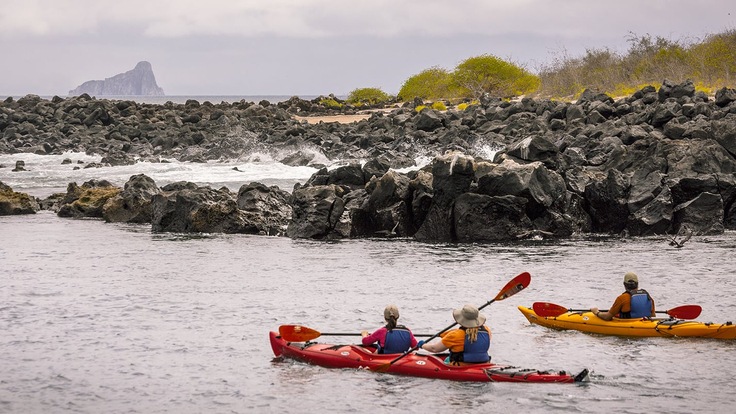The most important step in planning any paddling trip is choosing an appropriate route to follow. The route you choose will define (to a large degree) the challenges you face, the obstacles you encounter and the wilderness experiences you enjoy along the way.
Start with a Good Trip Distance
Once you've decided on a paddling group and established everyone's skill level, the next step in planning a camping trip is to decide how long you want your paddling route to be. Start by figuring out how much actual paddle time you'll have, based on the number of days you have available for the trip and how far from home you want to travel to get to your put-in point.
A General Estimate
Estimating how far your group will want to paddle each day can be tricky. There are a number of factors that can affect how fast a paddling group can travel, including:
- The type of water being paddled (fast river vs. flat water, for example)
- The experience levels of the paddlers
- Wind, water, and weather conditions
- The types of boats being paddled
- The overall length of the trip
One of the most common mistakes made by novice paddle campers is trying to cover too much distance. Overly-aggressive plans typically result in long paddle days, sore muscles, bad moods and missed opportunities along the way.
As a rough estimate, plan on traveling no more than two or three miles per day in good conditions on flat water if you're a beginner; slightly more when following a current or a wind, considerably less in adverse conditions. Be sure to keep track of your progress during your first several trips, so you can adjust your distance estimates based on actual experience.
Don't Forget the Fun Stuff!
Remember that there's more to paddling than simply paddling all day. Make sure your daily distance estimates include plenty of time off for resting, exploring, sightseeing and other non-paddling activities. Also consider factors that might slow your group down like bad weather, equipment breakdowns, injuries or illnesses.
Finally, keep in mind as you plan your trip route that your group is only as fast as its slowest member. To improve your cruising speed:
- Team inexperienced paddlers with more seasoned group members
- Team stronger paddlers with weaker ones
- Switch up boat teams every now and then for fresh conversation and a change of pace
- Remember to rest: Going full out day after day will be slower in the long run than taking occasional breaks to rest and recuperate
Researching Routes
When the time comes to start researching possible paddling routes, keep your eyes open for the following route features:
- Natural hazards
These include obstacles like river rapids, long stretches of exposed water and potentially dangerous land formations (bottleneck canyons, steep-walled valleys). Avoid natural route hazards as much as possible, and make sure everyone in your group can handle the ones that are part of your route.
- Man-made obstacles
Man-made obstacles include things like dams, low bridges and off-limits areas (wildlife refuges, private property). Evaluate these obstacles carefully as you plan, and make sure your group can get around (or though) them safely.
- Accessible landing and launching areas
Plan routes with easily accessible landing and launching zones. These zones should be easy to reach from both the land and the water, and they should be well spaced throughout the route (in case wind/weather/water conditions force you to seek shelter).
- Nearby attractions and side trips
Exciting non-paddling activities can be a major part of memorable paddling adventures. Keep your eyes open for route-side attractions like hiking trails, hidden beaches, beautiful views and more.
- Established campsites
Established campsites make camping easier and help keep your impact on the land to a minimum. Plan your routes to take advantage of them when you can (in some popular paddling areas, paddlers are required to use established sites). When planning a route through an area without established campsites, make sure there are safe, accessible locations throughout the route for setting up camp.
- Established portage routes
Portage routes are pathways that allow paddlers to bypass difficult stretches of water and/or travel from one body of water to another. They're usually found on river or lake routes, but they can be found along the coast as well. Long portage routes can be difficult, especially if the terrain is tough or your boats and gear are heavy. If you're a beginner, try to avoid portages as much as possible. If you have to use them, ask other paddlers or the local land manager to make sure they are well-marked and well maintained.
NOTE: Experienced paddlers often include a few tough portages in their routes on purpose, so they can enjoy less crowded waters.
- Distance to "civilization"
The further away your route is from civilization, the more skilled and self-sufficient you and your paddling partners will have to be. If you're just starting out, stick close to home or other civilization, just in case.
The Float Plan
Once you've chosen and finalized your paddling route, write down a detailed float plan and leave it with a friend, a ranger or the Coast Guard (whomever is most appropriate). This written plan should include your:
- Expected time of departure
- Expected route of travel
- Expected and alternate stopping points along the way
- Final destination
- Expected arrival time at the take-out
Make plans to contact the person holding your float plan as soon as your trip is finished. You should also arrange for that person to contact the appropriate authorities if he or she does not hear from you within a certain timeframe.
